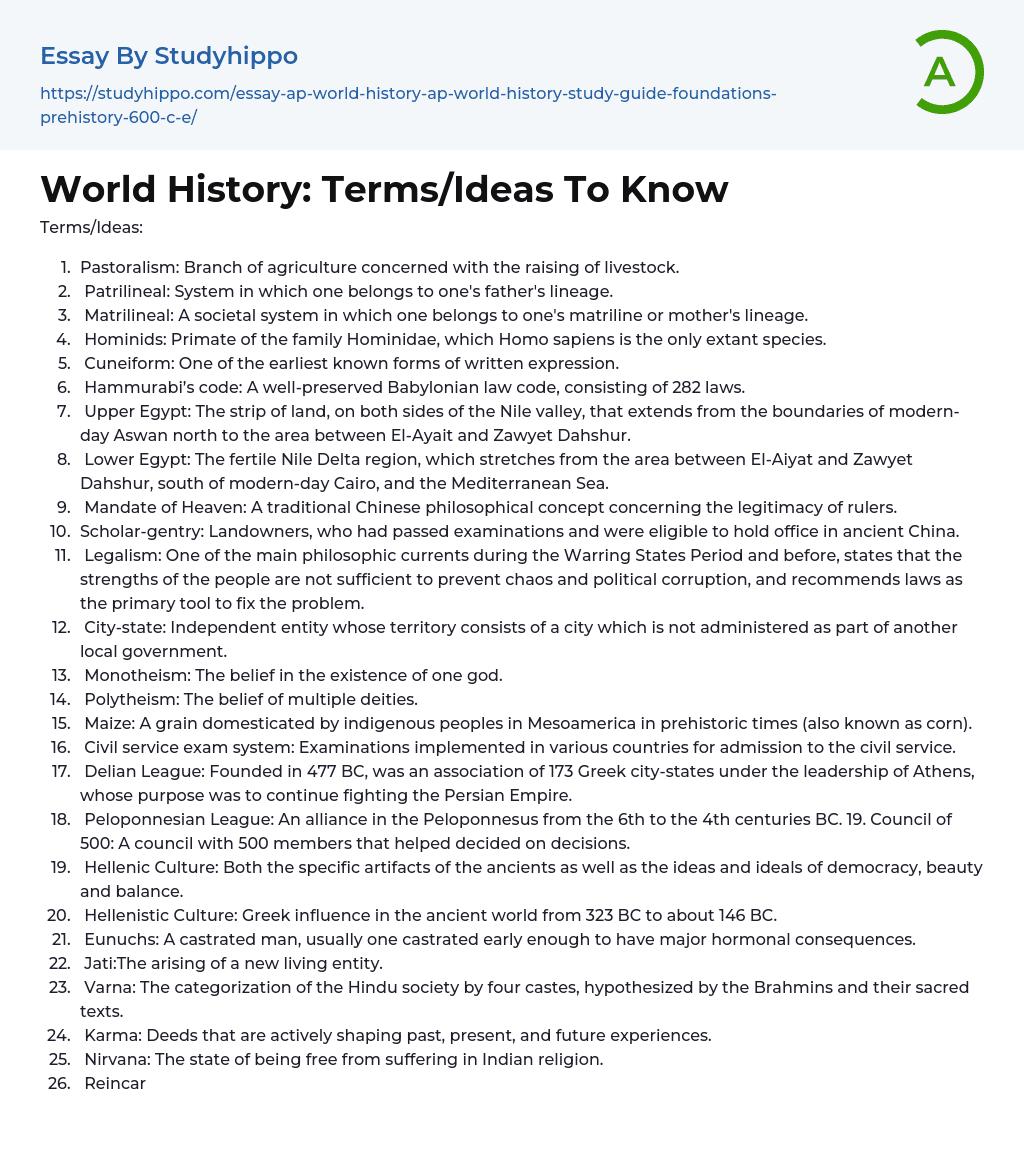World history is a branch of historical science that studies the history of the human world. World history studies and describes the process of development of human society as a whole, with characteristic patterns manifested in the history of all peoples.
Terms/Ideas:
- Pastoralism: Branch of agriculture concerned with the raising of livestock.
- Patrilineal: System in which one belongs to one's father's lineage.
- Matrilineal: A societal system in which one belongs to one's matriline or mother's lineage.
- Hominids: Primate of the family Hominidae, which Homo sapiens is the only extant species.
- Cuneiform: One of the earliest known forms of written expression.
- Hammurabi’s code: A well-preserved Babylonian law code, consisting of 282 laws.
- Upper
...Egypt: The strip of land, on both sides of the Nile valley, that extends from the boundaries of modern-day Aswan north to the area between El-Ayait and Zawyet Dahshur.
- Lower Egypt: The fertile Nile Delta region, which stretches from the area between El-Aiyat and Zawyet Dahshur, south of modern-day Cairo, and the Mediterranean Sea.
- Mandate of Heaven: A traditional Chinese philosophical concept concerning the legitimacy of rulers.
- Scholar-gentry: Landowners, who had passed examinations and were eligible to hold office in ancient China.
- Legalism: One of the main philosophic currents during the Warring States Period and before, states that the strengths of the people are not sufficient to prevent chaos and political corruption, and recommends laws as the primary tool to fix the problem.
- City-state: Independent entity whose territory consists of a city which is not administered as par
View entire sampleJoin StudyHippo to see entire essay
of another local government.
to fully devote one's self to spiritual work.
the Torah is traditionally attributed.
religious or spiritual belief that souls or spirits exist not only in humans but also in all other animals, plants, rocks, natural phenomena such as thunder, geographic features such as mountains or rivers, or other entities of the natural environment.
499 BC and lasted until 449 BC. The collision between the Greeks and the enormous empire of the Persians began when Cyrus the Great conquered Ionia in 547 BC. The Greeks came out victorious.
was followed by the Qin Dynasty in China. The Zhou dynasty lasted longer than any other dynasty in Chinese history, and the use of Iron was introduced to China during the Zhou Dynasty.
Greece, leading the Delian League in the Peloponnesian War against Sparta and the Peloponnesian League. In the classical period, Athens was a center for the arts, learning and philosophy, home of Plato's Akademia and Aristotle's Lyceum, Athens was also the birthplace of Socrates, Pericles, Sophocles, and many other prominent philosophers, writers and politicians of the ancient world.
from 320 to 550 CE and covered much of the Indian Subcontinent. This period is called the Golden Age of India and was marked by extensive inventions and discoveries in science, technology, engineering, art, dialectic, literature, logic, mathematics, astronomy, religion and philosophy that crystallized the elements of what is generally known as Hindu culture.
succeeded the Parthian Empire, was known as one of the two main powers in Western Asia and Europe, alongside the Roman Empire and later the Byzantine Empire, for a period of more than 400 years.
mankind" and has been highly praised. It is considered among the most important texts in the history of literature and philosophy.
- Ancient Rome essays
- Augustus essays
- Byzantine Empire essays
- Julius Caesar essays
- Roman Republic essays
- Mark Antony essays
- Han Dynasty essays
- Middle Ages essays
- Ottoman Empire essays
- Romanticism essays
- Renaissance essays
- Reformation essays
- Cuban Missile Crisis essays
- Fidel Castro essays
- Imperialism essays
- Samurai essays
- Soviet Union essays
- Hiroshima essays
- Mongols essays
- Nelson Mandela essays
- Jack The Ripper essays
- French Revolution essays
- Reign of Terror essays
- Scientific Revolution essays
- Roaring Twenties essays
- Mao Zedong essays
- Abolitionism essays
- Adam Smith essays
- American History essays
- American Revolution essays
- Ancient Egypt essays
- Articles Of Confederation essays
- Atlantic Slave Trade essays
- Aztec essays
- Benjamin Franklin essays
- Civil Rights Act of 1964 essays
- Civil Rights Movement essays
- Civil war essays
- Cleopatra essays
- French And Indian War essays
- Gettysburg essays
- Great Depression essays
- Hurricane Katrina essays
- Industrial Revolution essays
- Jamestown essays
- Manifest Destiny essays
- Mccarthyism essays
- Patrick Henry essays
- Pearl Harbor essays
- Pocahontas essays




